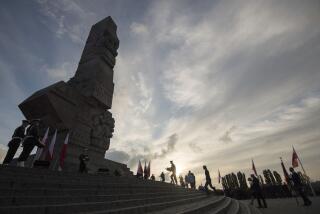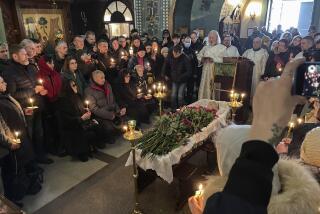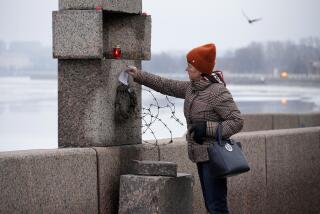Contrite Yeltsin Attends Modest Services for Czar
ST. PETERSBURG, Russia â Russia laid to rest the last czar of its 300-year-old Romanov dynasty Friday after a stirring apology from President Boris N. Yeltsin for the âmonstrous crimeâ that still haunts this country 80 years after Nicholas II and his family were executed by Bolshevik gunmen.
Yeltsinâs heartfelt repentance sought to reunite a nation divided by conflicting memories of an era baptized with the blood of the Romanovs. Communist rule is now remembered by some with tearful pride for its defeat of fascism and by others as a brutal dictatorship that killed its own people for political aims.
To salve the wounds opened by Russian ancestors, Yeltsin called for truthful reflection on this century of bloodshed and âan expiation of common guilt.â
âGuilty are those who committed this heinous crime, and those who have been justifying it for decades--all of us,â Yeltsin told about 300 mourners at the Saints Peter and Paul Cathedral for a funeral that culminated with a deafening 19-gun salute. âI bow my head before the victims of this merciless slaying.â
Nicholas and his wife, Alexandra, their five children and four loyal servants who followed the family into exile were shot and bludgeoned to death in the Ural Mountains city of Yekaterinburg on July 17, 1918. The crude forest pit into which the Bolsheviks dumped the hacked and burned remains of the Romanovs was discovered 20 years ago and exhumed after the fall of communism in 1991.
In the seven years since Yeltsin ordered a government commission to investigate and identify the remains, repeated DNA tests have proved their authenticity but done little to guide Russians toward reassessment of the Communist actions in executing the royals or to set this troubled nation on the path to renewal.
âThis is not just a funeral but a national repentance,â Russian-born conductor Mstislav Rostropovich said of Fridayâs rituals. âIt shows the entire world that Russia is changing and becoming more humane.â
But for descendants of the Romanov dynasty who managed to flee abroad before the 1917 Bolshevik Revolution, Fridayâs solemn ceremonies, with incense wafting and cathedral bells tolling, represented a long-awaited moment of closure.
âWe came here to take care of some unfinished family business, and weâve finished it,â Rostislav Romanov, 58, the grandnephew of Nicholas, said after the two-hour funeral. âI thought it was all wonderful. I feel relieved.â
Nine small caskets holding the bones of Nicholas and Alexandra, three of their five children and the four servants--the remains of Crown Prince Alexei and his sister Marie have never been located--were lowered into a crypt below the floor of the 18th century cathedral. Relatives tossed in handfuls of sand to symbolize the traditional commitment of the dead to the earth.
Yeltsinâs bold decision to take part in the ceremonies despite fierce objections by the Russian Orthodox Church went far in rescuing what threatened only a few days ago to turn into a public fiasco of boycotts, protests and political grandstanding.
The church has been caught in a huge rift with its membership abroad, which long ago declared Nicholas a holy martyr. To agree with that conclusion, though, would expose the Russian Orthodox Church, newly resurgent and now wielding great sway as almost a state religion, as a Communist collaborator.
The church, instead, has refused to accept the scientific evidence identifying the Yekaterinburg remains as those of the slain Romanovs. Its judgment inspired many of the faithful, most politicians and some members of European royal houses to keep their distance.
But even Yeltsinâs last-minute decision to make amends âas a man and as presidentâ fell short of the conscience-cleansing ritual of reconciliation he had hoped for. Religious and nationalist demonstrations tainted the ceremonies, and the vast majority of Russians simply ignored the events.
The services, which began at noon with three blasts from the Saints Peter and Paul Fortress cannon, were closed to the public and screened from the curious by the stone walls surrounding the isle.
Still, about 1,000 people gathered on the sun-splashed banks of the Neva River in hopes of a glimpse of Kremlin dignitaries or the remote royals. Live television coverage of the dirges and entombment brought the rituals into every home where they were of interest.
âThis puts a period at the end of an era. Now people will have no cause to argue about what happened or to think about it anymore,â said Tatiana Ananeva, a physician who stood vigil outside the fortress in an act of contrition for a lifetime spent in ignorance about what the Communists she once supported did to the deposed Romanovs.
Fretful indecision among the funeralâs government planners in the wake of the churchâs boycott meant a curtailed budget for the event. However, the modesty of the ceremonies pleased the relatives and well-wishers as much as officials under fire for neglecting more immediate public spending needs.
âIâm glad the ceremony was simple. Iâm sympathetic to the czarâs family--it was especially cruel to kill his young daughters--but Iâm a doctor and I havenât been paid by the government for three months,â said Marina Kamusidi, who paid her respects from an embankment by listening to the guns and church bells.
As Russian officials, foreign diplomats and the relatives of the Romanovs toasted the rectified burial of Nicholas and his loved ones at a reception at the Ethnographic Museum, several hundred Orthodox faithful held a dissenting requiem at the newly restored Cathedral of the Spilled Blood.
Orthodox priests carrying monarchist banners and icons led mourners in a procession around the ornate church named for the scene of the 1881 assassination of Nicholasâ grandfather, Alexander II.
Velvet-robed priests and a crowd of mostly elderly believers chanted prayers for the last czar, and nationalist politicians sprinkled among the mourners denounced the fortress burial as sacrilege and fakery.
Yeltsin risked the wrath of Russiaâs multitudes of newly faithful with his decision to break ranks with the church and lend official sanction to the burial service. But the aging president with a savvy sense of how to capture a historical moment also set himself apart from other leaders of the Communist era by acknowledging the culpability of those who were part of the conspiracy of silence about the killing of the Romanovs.
It was Yeltsin who served as Communist Party chief in the Yekaterinburg region in 1977 when the order was received--and carried out--to raze Ipatiev House, where the Romanovs were executed in a predawn melee of bullets and bayonets.
âWe must finish this century, which has become the century of blood and lawlessness for Russia, with repentance and reconciliation irrespective of political and religious views and ethnic origin,â Yeltsin told the mourners and his countrymen after the services on live TV. âThis is our historic chance. On the eve of the third millennium, we must do it for the sake of our generation and those to come. Letâs remember those innocent victims who have fallen to hatred and violence. May they rest in peace.â
More to Read
Sign up for Essential California
The most important California stories and recommendations in your inbox every morning.
You may occasionally receive promotional content from the Los Angeles Times.











